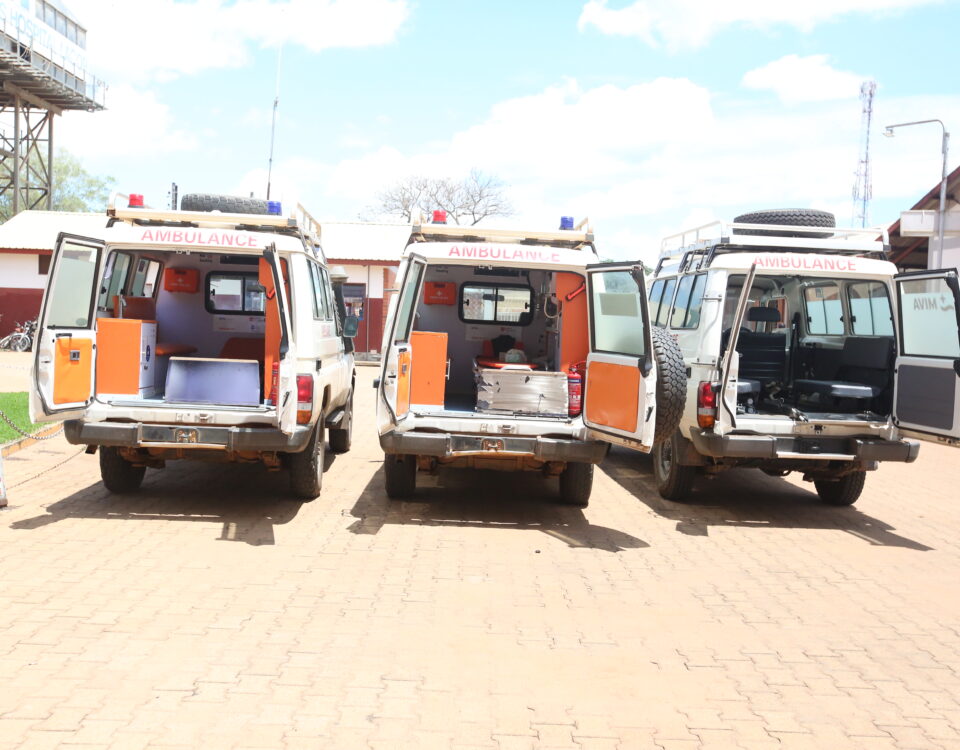Atim’s Diary: Excellence and commitment in the face difficulties at Lacor
February 24th, 2023
Dear all,
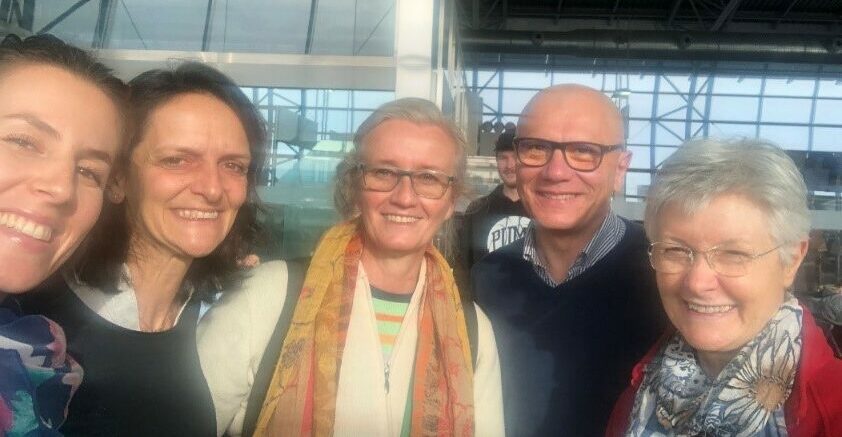
This time I am on a special mission: I have the great pleasure of accompanying Prof Pietro Invernizzi, director of the Department of Medicine and Surgery of the University of Milan-Bicocca, to Lacor. With us are his wife Stefania Recalcati, also a physician and associate prof. in general pathology at the University of Milan, Maria Luisa Melzi pediatrician at the San Gerardo dei Tintori Hospital in Monza and Elena Vendramin, a pediatric nurse.
The Milano Bicocca Faculty intends to start a global health hub, and Lacor will be one of its partners. In addition to the technical and scientific learning on diseases, medicine must also deal with the whole of humanity and with the equitable distribution of care. Spending a training period of a few months in a culturally very different working environment with limited resources, dealing with diseases, diagnostic means and treatments that are different from those common in western countries, offers ample opportunities for growth in terms of awareness that, at every latitude, resources are not limitless; critical rethinking of appropriateness of investigations and treatments, but also of leadership, communication, openness to a world that is very close and very distant at the same time.
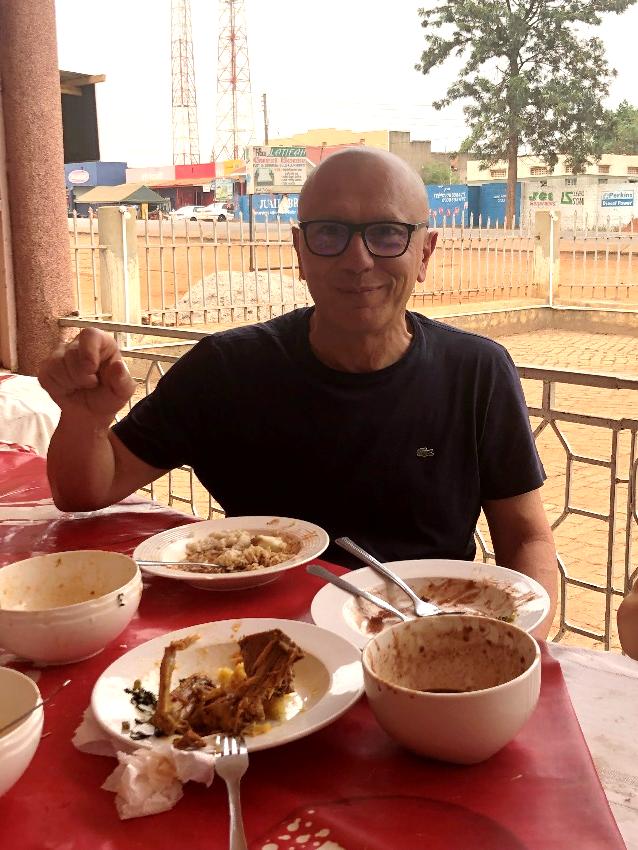 After a seven-hour flight with a one hour stop in Kigali, the capital of Rwanda, and after another hour of flight we are in Entebbe, where we spend the night.
After a seven-hour flight with a one hour stop in Kigali, the capital of Rwanda, and after another hour of flight we are in Entebbe, where we spend the night.
The following day we leave for Gulu, with a quick stop halfway for a local flavor: matoke (cooked bananas that replace potatoes), sweet potatoes, beans and chicken.
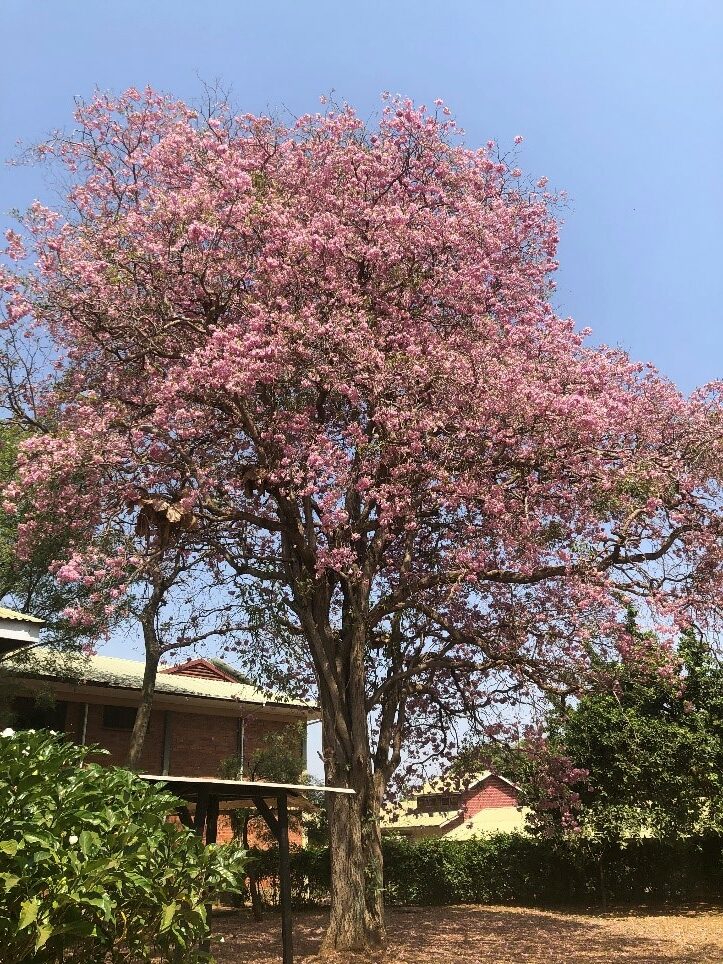 At Lacor I am delighted to find the tabebuia tree in full bloom in my garden: it only happens in February, when all the leaves fall off and the tree turns into a pink cloud. After a few weeks it fades and in March, with the rainy season, it turns green again. I hadn’t seen it in bloom for years.
At Lacor I am delighted to find the tabebuia tree in full bloom in my garden: it only happens in February, when all the leaves fall off and the tree turns into a pink cloud. After a few weeks it fades and in March, with the rainy season, it turns green again. I hadn’t seen it in bloom for years.
On Monday morning we meet the Dean of the Gulu University Medical Faculty, Prof Felix Kaducu, and several professors. Dr. Odong Emintone, Consultant Gynecologist and Medical Director of Lacor, as well as Honorary Dean of the Faculty, accompanies us. The meeting brings out everyone’s immense desire to improve training and health care, despite the limited human and financial resources.

Back at Lacor we go straight to the Children’s ward, where Dr Venice Omona, pediatrician and Head of the large pediatric department, awaits us.
The pediatricians from San Gerardo and Lacor Hospitals, with the support of Milano-Bicocca and Gulu universities, have just presented a proposal to a EU Erasmus Plus call which, once approved, could financially support exchange projects between the two departments.
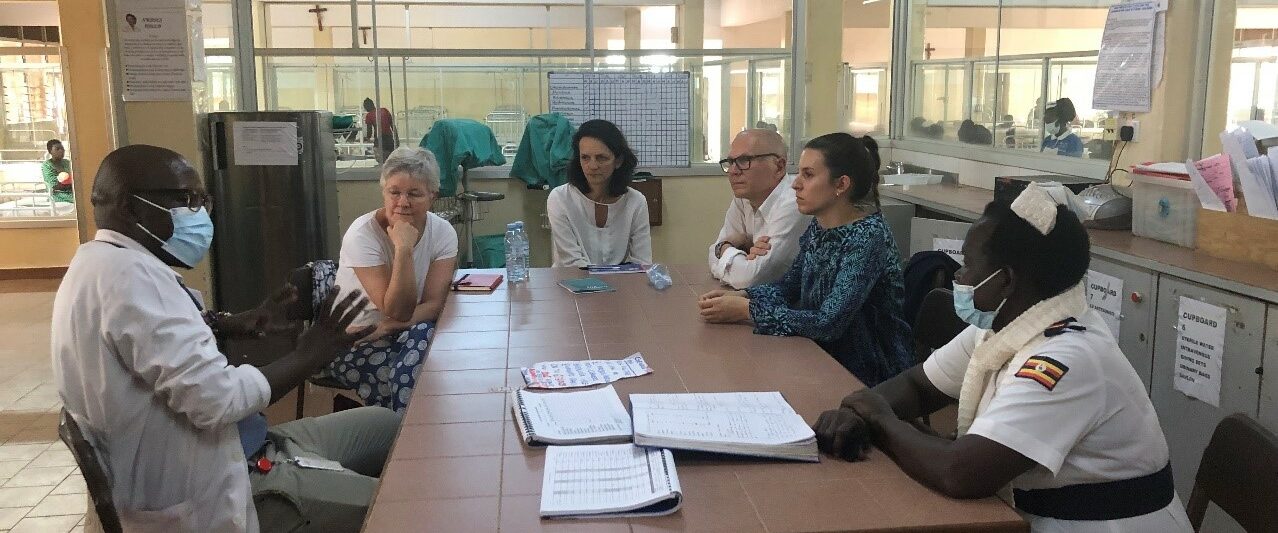
The days that follow before their departure are full of meetings with the directors, other meetings and tours of the Hospital, as well as unending discussions on multiple fronts regarding health cooperation and immersions even in the most marginal aspects of Lacor Hospital.
To the north of the Hospital compound, the new staff houses are growing rapidly thanks to the great generosity of a family foundation, struck by the conditions of a hastily built housing complex during the war years. At the time they had been a boon to staff and to their families, given the danger of traveling on the roads, but now they are in a truly dilapidated state.
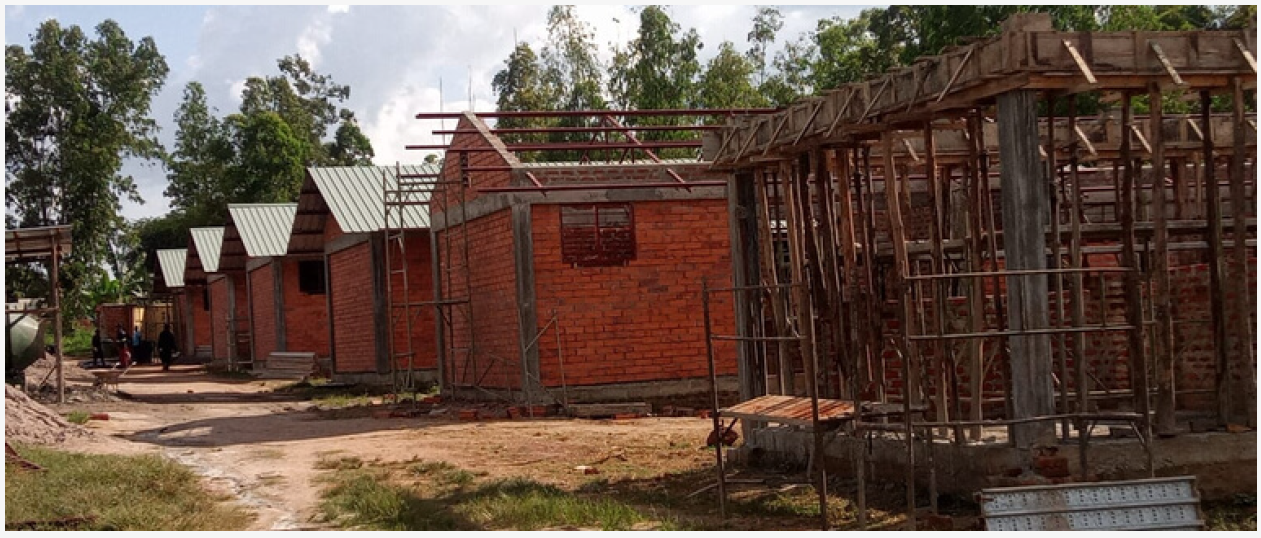
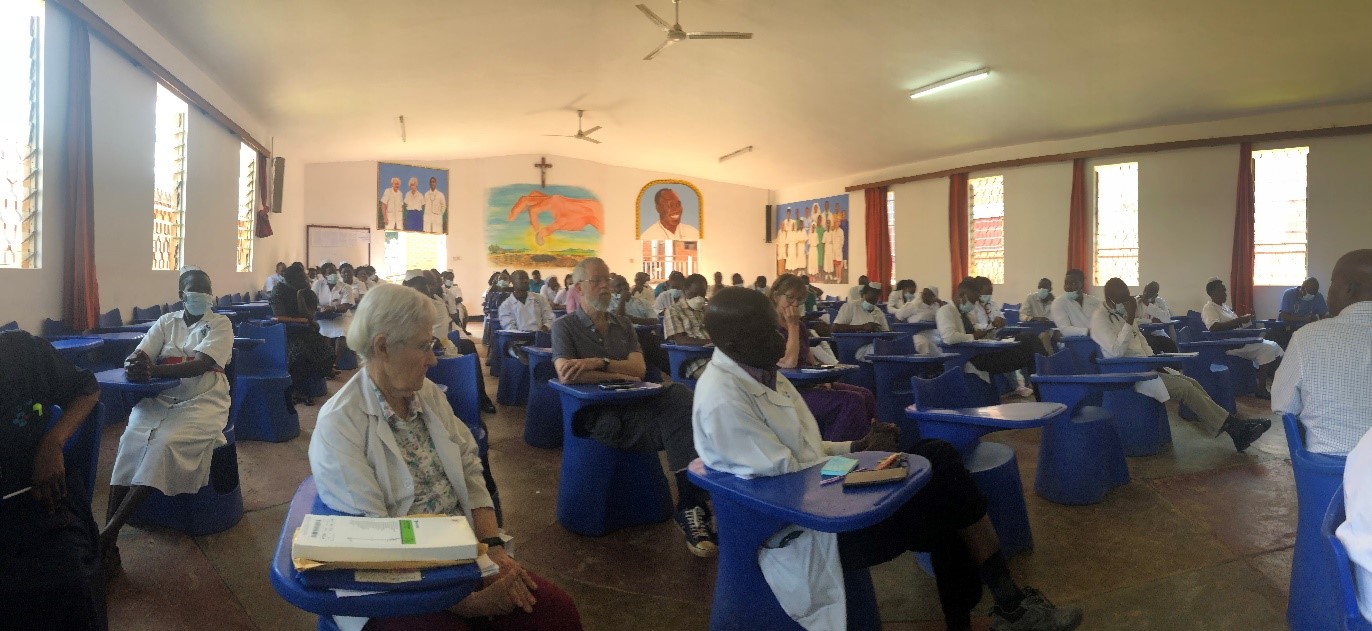 At the usual Continuous Medical Education (CME) meeting on Saturday morning, two pharmacist interns present a detailed analysis of the most common errors committed in prescribing, transcribing, preparing, administrating drugs in hospital or when the giving them to discharged patients. These meetings are very important for spreading a non-punishing culture of recognizing the error, which is the first step towards improving processes and preventing errors.
At the usual Continuous Medical Education (CME) meeting on Saturday morning, two pharmacist interns present a detailed analysis of the most common errors committed in prescribing, transcribing, preparing, administrating drugs in hospital or when the giving them to discharged patients. These meetings are very important for spreading a non-punishing culture of recognizing the error, which is the first step towards improving processes and preventing errors.
They also testify to the vitality of a Hospital that not only “does” and “does a lot”, but which, despite a very, very disadvantaged context, does not give up rethinking what it does and how to do it better.

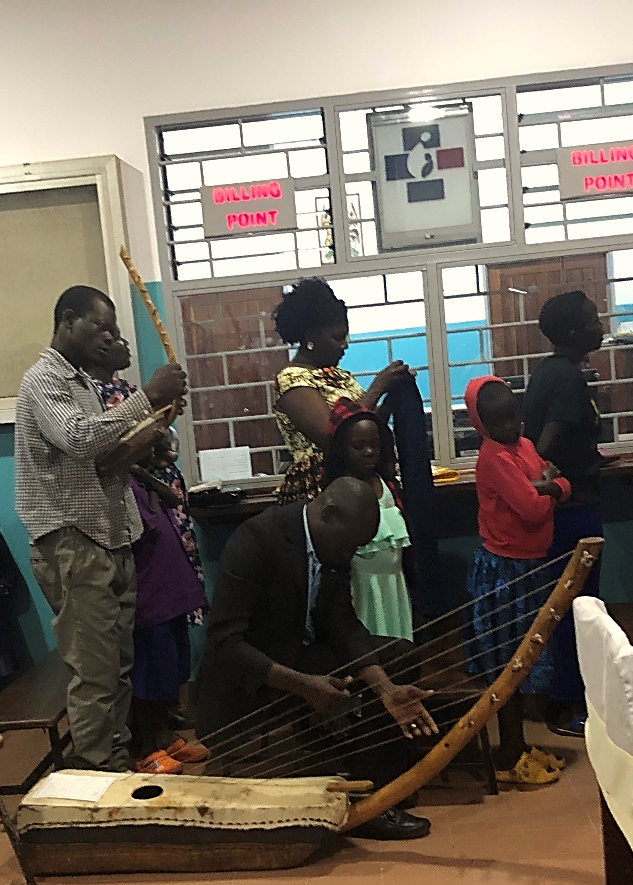 On Sunday, the 7 o’clock Mass, which is again celebrated under the verandah of the administration block, as before the Covid. It is very crowded and is very popular and enlivened by the harmonious songs that pervade all festivities here.
On Sunday, the 7 o’clock Mass, which is again celebrated under the verandah of the administration block, as before the Covid. It is very crowded and is very popular and enlivened by the harmonious songs that pervade all festivities here.
It is a community that comes together: I am happy to see Dr. Emmanuel, epidemiologist in charge of the research and HIV department (with over 7,000 patients on anti-retroviral treatment) and, as from January, one of the Hospital’s four new deputy directors. With him is his wife Dr Pamela, a specialist in Public Health with a previous degree in Environmental Health who works for Gulu University.
They both sing, Dr Emmanuel plays the great adungu, a traditional harp, while Dr Pamela plays the ajaa, a hollow instrument containing seeds: by rhythmically tilting the instrument, the seeds produce an accompanying sound.
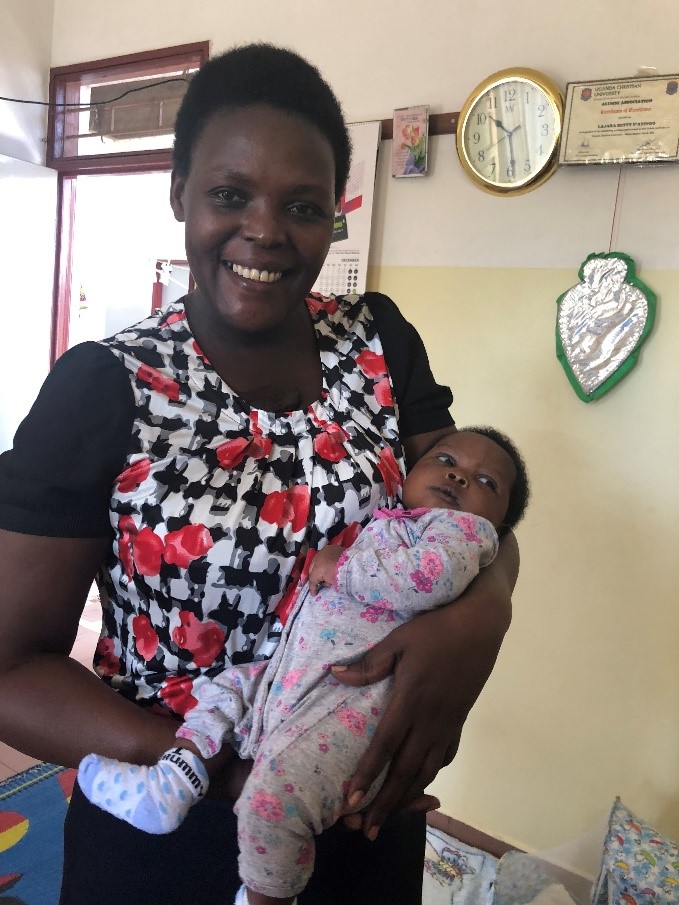 After breakfast with Elisabetta, the colleague in charge of the projects, we go to see Sister Betty Lajara P’atingo, one of the matrons (directors of the nursing services and of the hospital’s quality team) who had a beautiful baby girl a month ago. Elisabetta, who works a lot with her on the Result Based Financing (RBF) project, brought her a dress as a gift.
After breakfast with Elisabetta, the colleague in charge of the projects, we go to see Sister Betty Lajara P’atingo, one of the matrons (directors of the nursing services and of the hospital’s quality team) who had a beautiful baby girl a month ago. Elisabetta, who works a lot with her on the Result Based Financing (RBF) project, brought her a dress as a gift.
The baby girl was named Pi Kica (pron. Kisa), which means “By Grace”. Her Christian name is Antonia, after the saint of the day of her birth.
Locally, family names are uncommon. Each child is given a local name, which always has a meaning concerning an event that happened to the child, to the mother, to the family or to the region during the birth, as well as a Christian name.
The following day, despite still being on vacation, Dr Emmanuel holds a non-stop meeting from 8.30 to 1 PM. The hospital is reviewing the indicators that are verified quarterly that help to maintain and improve quality.
For each department included in the project (mother and child clinics, paediatrics, gynecology, medicine) and for cross-cutting services (laboratory, pharmacy, compound cleaning) there are from 40 to over 100 indicators concerning various areas such as hygiene and infection control, infrastructure, nursing processes, clinical processes, drug management, emergency management, student supervision). The indicators are discussed to verify if they are still adequate or should be modified, new ones added, if needed.
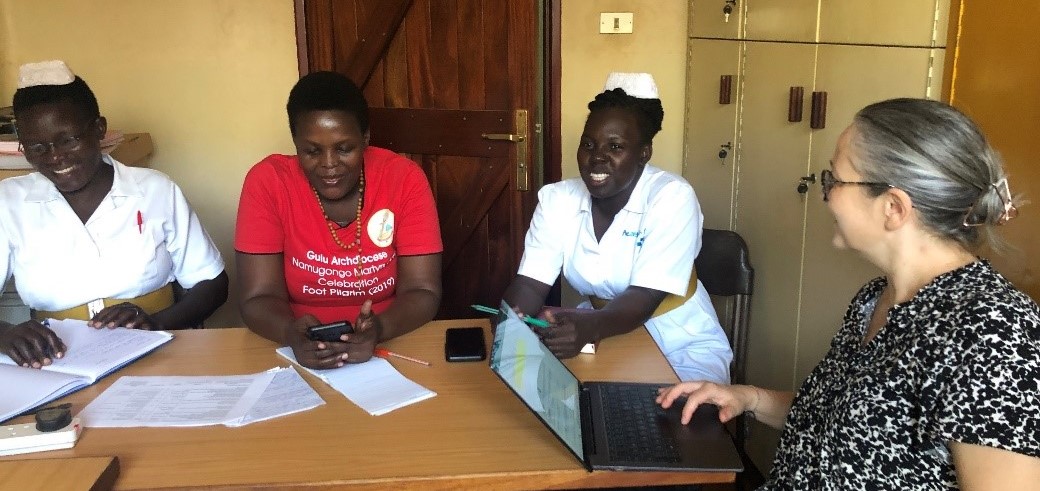
For Elisabetta and for myself, these meetings have been a real “energy boost”: listening to the discussions between Dr. Emmanuel and the three very proactive nurses was exciting: it allowed us to learn a lot about the complexity of the processes that are needed to treat people despite the great difficulties.
Several major donors fund the Hospital’s Result Based Funding project. This output-based funding is based on quarterly verifications of quantity and quality indicators. This invaluable support allows the Hospital to heavily subsidize the care that is offered to the people. This in turn ensures that the poorest sections of the population are not excluded from access to treatment.
On the 30th anniversary of the birth of the Corti Foundation, I am very proud of how mom and dad, right from the start, laid the foundations of an approach that goes precisely in the direction of the “Grand Bargain” principles set in May 2016 during the World Summit on Humanitarian Aid which allows for flexibility in managing humanitarian aid as well as finance the participation and inclusion of local actors among others.
We will never be able to adequately thank our donors for the generosity and foresight with which they have allowed us, for thirty years, to implement a kind of support that is now considered virtuous.
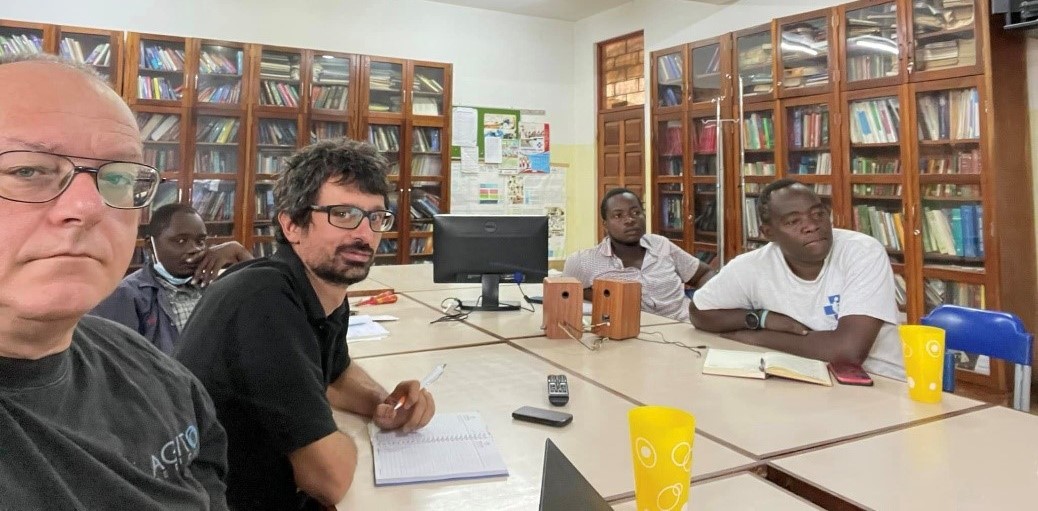 Fabio Bradach, has been collaborating for more than ten years as a volunteer in support of the technical department for everything related to electromedical devices is back at Lacor.
Fabio Bradach, has been collaborating for more than ten years as a volunteer in support of the technical department for everything related to electromedical devices is back at Lacor.
His main objective now is installing the OpenMAINT program which will help monitoring electro-medical devices and carry out preventive maintenance. Lacor is the first hospital to adopt such a sophisticated instrument in this part of the country. He sent me the selfie above during the online training with the software maintainer.
 Fabio is also an astronomy enthusiast and has brought one of his telescopes. This photo of the moon is the digital sum of about 2,000 frames taken at Lacor a few nights ago.
Fabio is also an astronomy enthusiast and has brought one of his telescopes. This photo of the moon is the digital sum of about 2,000 frames taken at Lacor a few nights ago.
We also had a monitoring visit by the Italian Agency for Cooperation and Development: Massimo Pasquali and Beatrice Geraci, accompanied by Paolo Giambelli (the agency’s coordinator in Uganda). In the photo below, they are visiting the electrical systems control room with Jacopo.
They were happy to observe that the RBF program continues, despite the end of the Agency’s three-year funding with which Lacor had started the RBF program in paediatrics.
On the morning of Elisabetta’s and my departure to return to Italy, we go to visit an interesting small company called Takataka Plastics, and its two nice, award-winning founders, Peter Okwoko and Paige Balcom. “Takataka” in Acoli (derived from Swahili) means “garbage”.
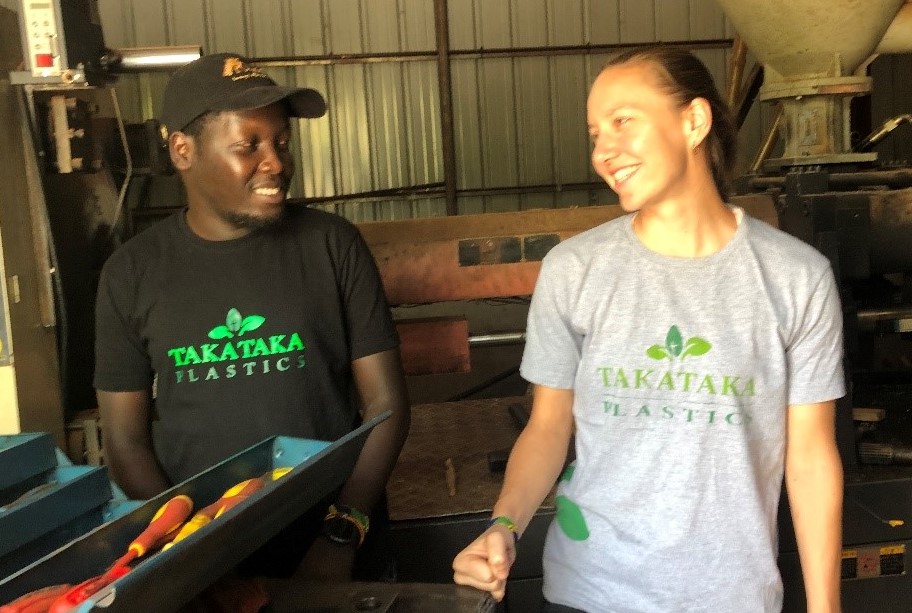 Aimed at changing people’s thinking regarding plastic as an untouchable and dirty “waste” into a potential resource, they produce everything from tiles, chairs, tables of good quality at affordable prices. They also create jobs for street children or young people who have suffered trauma: who make up half of the employees.
Aimed at changing people’s thinking regarding plastic as an untouchable and dirty “waste” into a potential resource, they produce everything from tiles, chairs, tables of good quality at affordable prices. They also create jobs for street children or young people who have suffered trauma: who make up half of the employees.
Peter and Paige show us around the company. A donor has given them funds to purchase larger land just outside Gulu, where they hope to move within a year. They also carry out education in schools and villages to convince people to collect plastic instead of burning it with garbage (a common and very dangerous practice because the low temperature causes the formation of harmful and carcinogenic substances).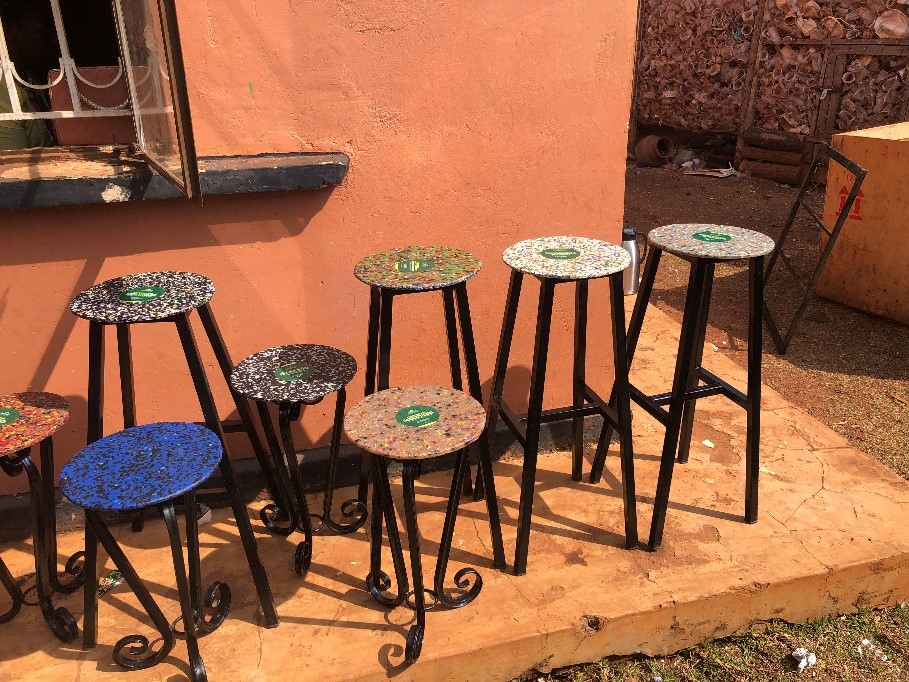
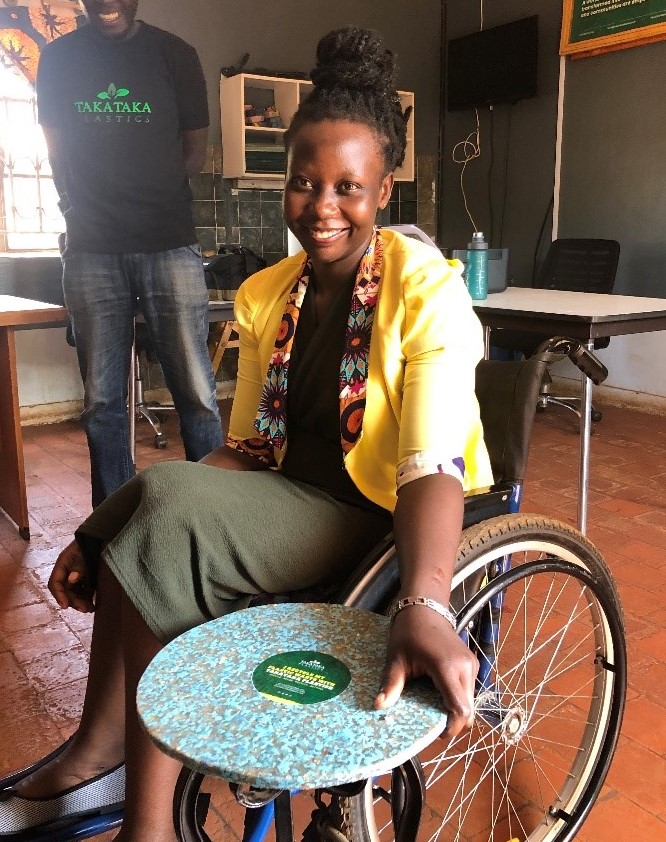 I take this opportunity to greet Nancy, who is carrying out her pre-graduate internship in Counseling at Takataka. Nancy is one of the many paralyzed girls and boys that Brother Elio helped. After his death, one of our donors continued to support her. The table on which her hand rests is made with plastic bottles from Lacor hospital intravenous fluids.
I take this opportunity to greet Nancy, who is carrying out her pre-graduate internship in Counseling at Takataka. Nancy is one of the many paralyzed girls and boys that Brother Elio helped. After his death, one of our donors continued to support her. The table on which her hand rests is made with plastic bottles from Lacor hospital intravenous fluids.
Her activity is to support Takataka employees with particularly difficult personal or family conditions with counseling, even in their villages.
In the space next to their business, they have set up a recreational area for kids using their own materials: chairs, tiles, decorations. It’s a way for kids to see and experience what can be done with plastic, taking it off the streets and out of bonfires, and giving it a dignified and useful second life.
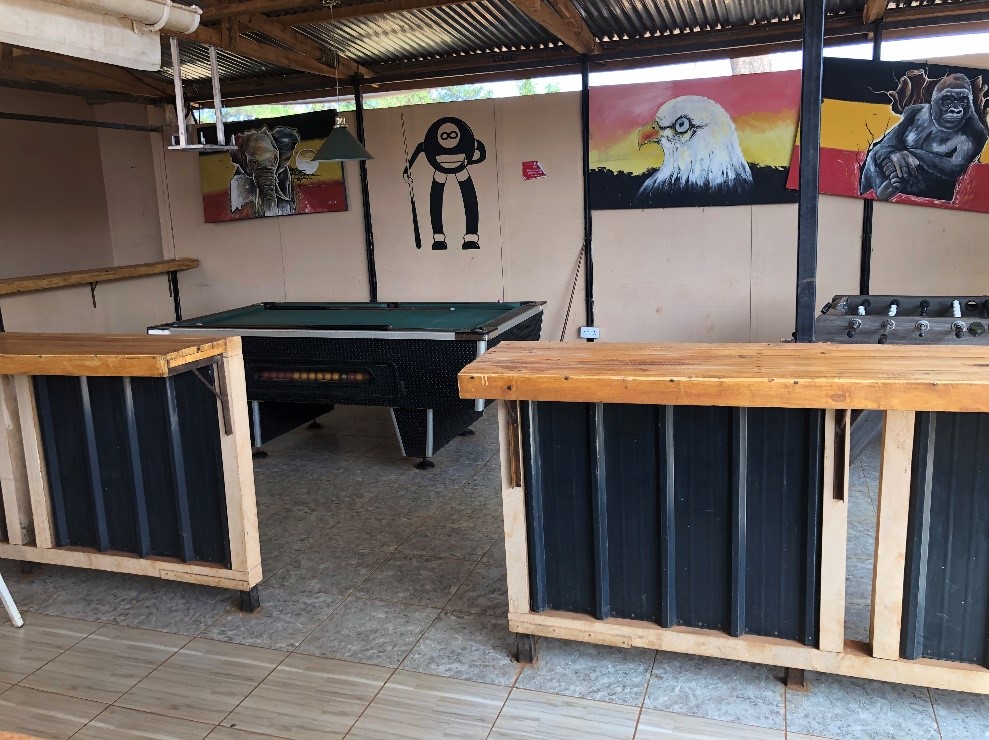
I had already visited before the Covid years, but I am filled with admiration for what they have developed and are achieving.
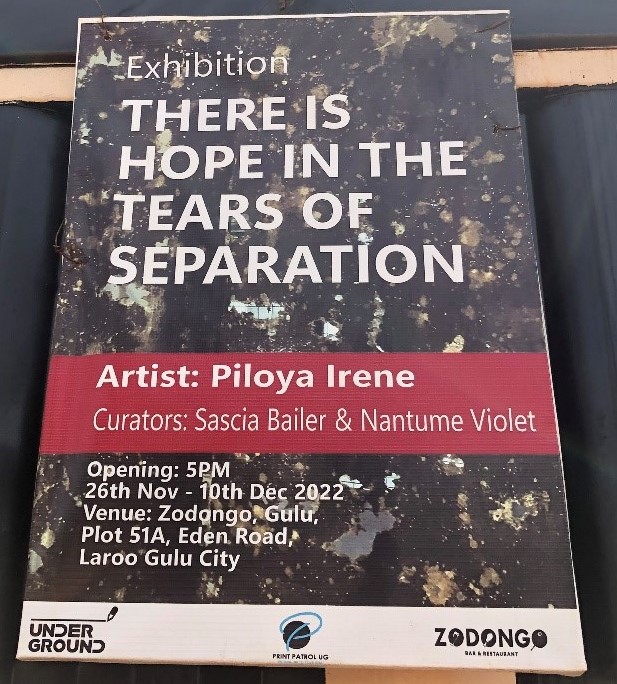
At the end of the tour, on the stage of the recreational area, the poster of an exhibition that was held in Gulu a few months ago strikes me.
The title seems to have been thought for me, in this moment of separation between my Lacor family and my Milan family: “there is hope in the tears of separation”.

